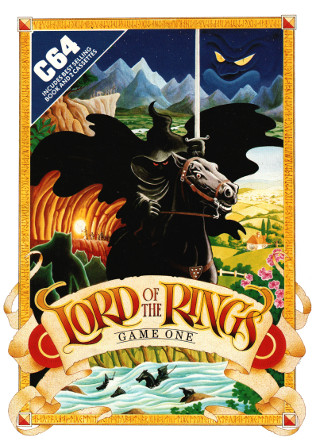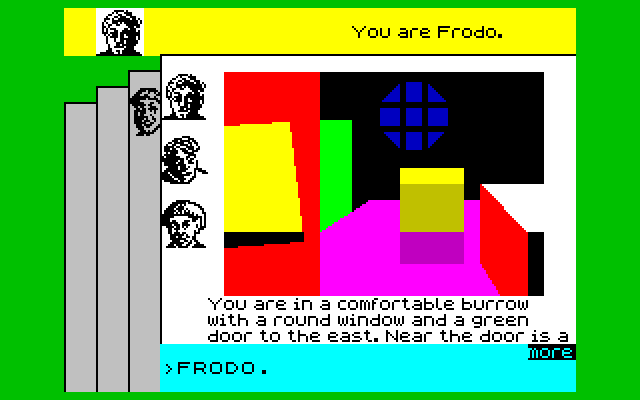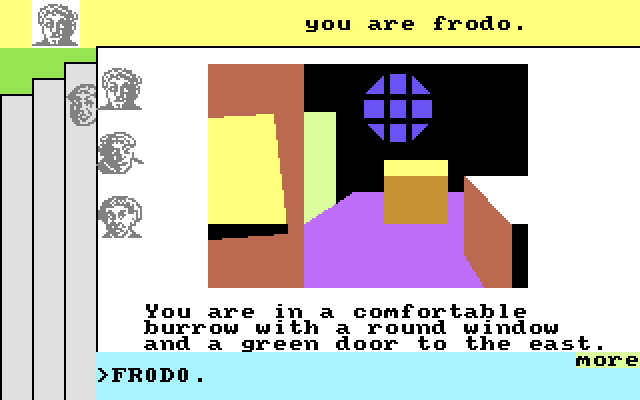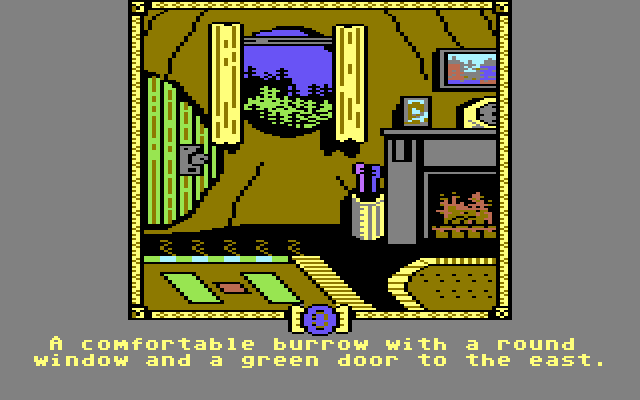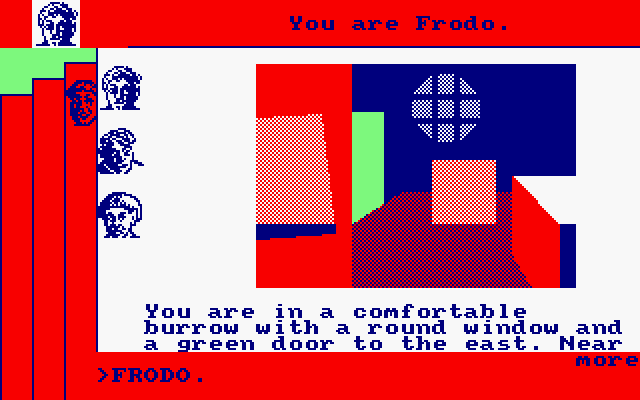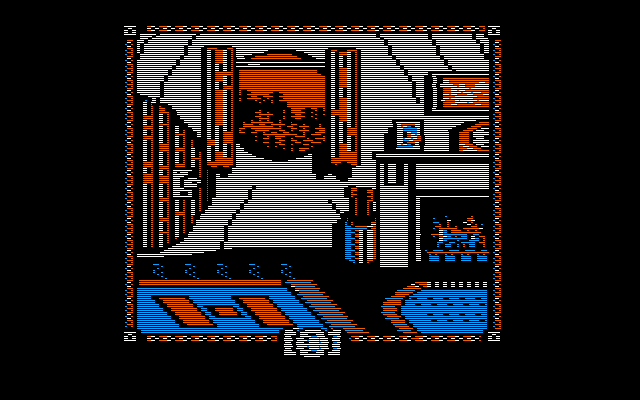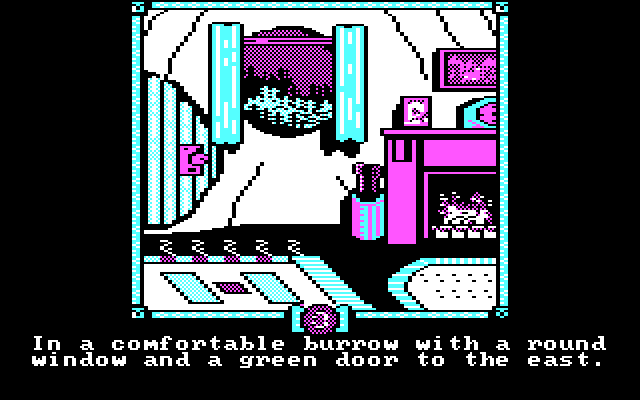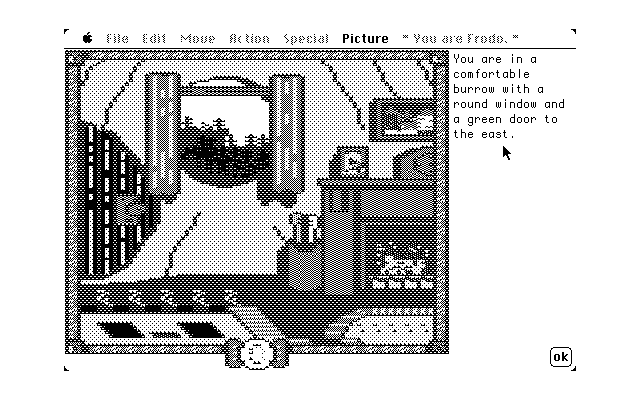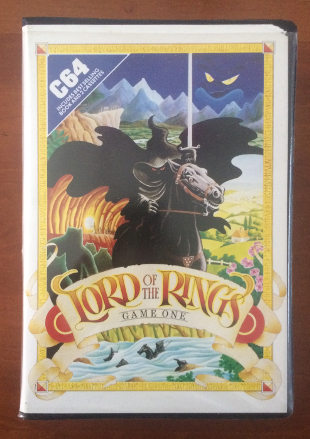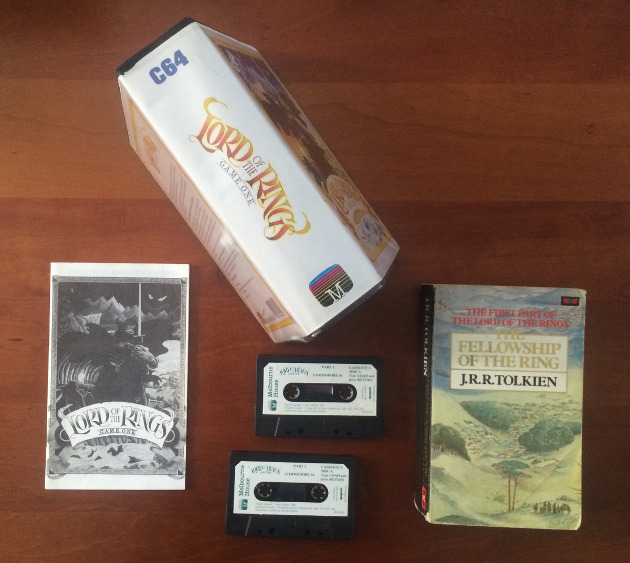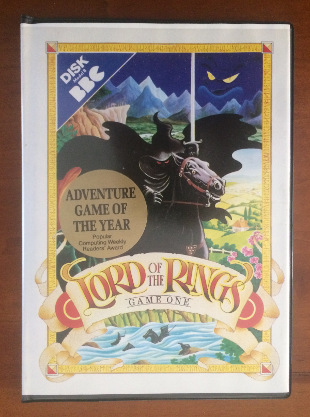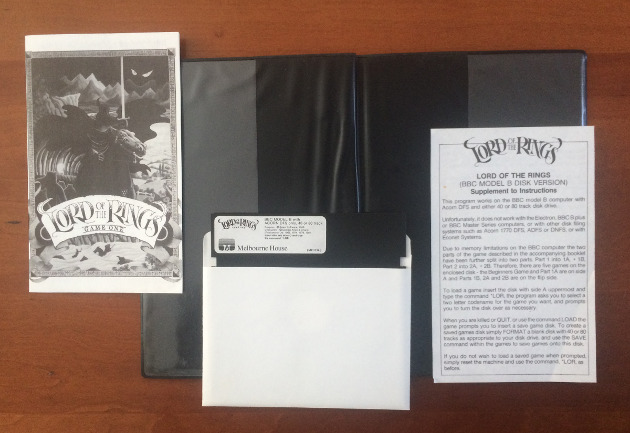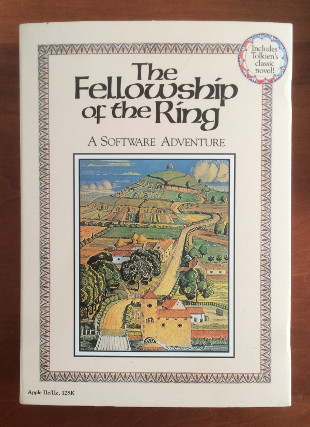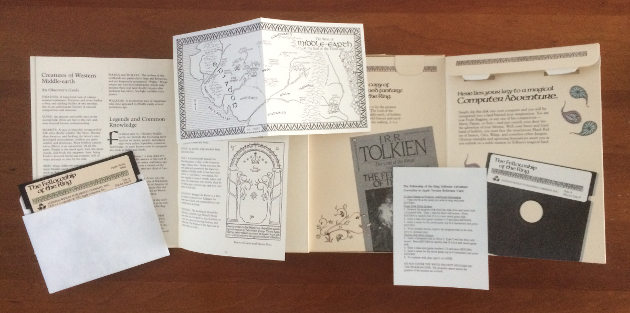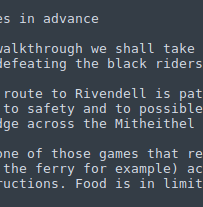
|
||||||||
|
Retrogaming |
Lord of the Rings Game One, part oneI got the cassette edition for the Commodore 64 as soon as it came out, and was much excited by the prospect of tracing Frodo's footsteps through Middle Earth. The game turned out to be quite different from what I expected. I never quite made up my mind about it, but maybe a revisit would help me reorganize my thoughts on it. The game is divided into two parts, roughly (but not exactly) matching the subdivision of the original into two books. This page is a twenty-first century review of the first part of the game. In it, some of the unusual aspects of the game are discussed. At the end there are pictures, a walkthough and a map too, but those are spoilers.
ContentsPlaying the gameGraphics and platforms Some notes for collectors Solution, pictures, and map (spoiler alert!) Links Playing the gameThis adventure is somewhat unusual compared to the established form of text games at the time this title came out. There is a role-playing feature built in, for example. At the start of the game, the user is asked to select which of the four famous hobbits he wants to play, Frodo, Sam, Pippin, or Merry. It is possible to select more than one character; in that case, switching between players is done by issuing "BECOME <character>". Normally, the non-user controlled characters in the presence of the player character will follow the latter when he moves to an adjacent room. 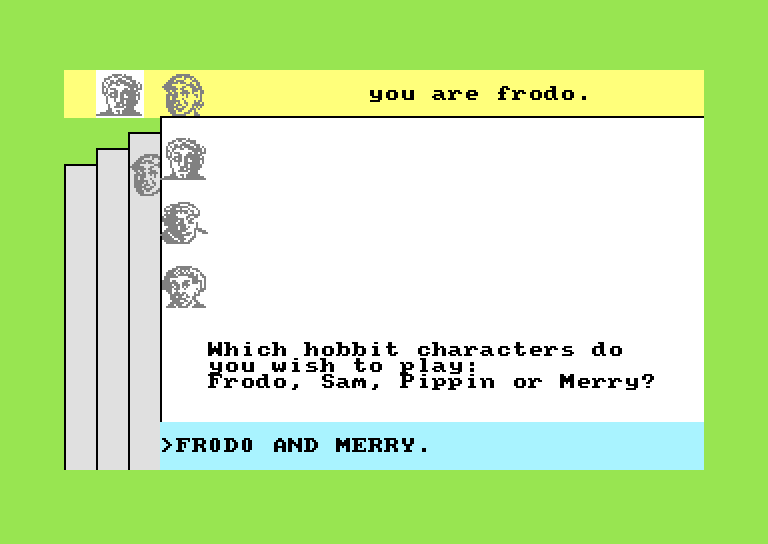 Selecting the player character on the Commodore 64. In this Melbourne House edition the mugs of our four hobbits are shown. The top line shows which of the characters the player has selected to play, and which of these is currently active. In the main screen we see the hobbits that are in the room with you; the absent Merry is apparently on the "next page". No score is kept, but a note pinned on the noticeboard in Bag End informs the player what his goal is: go to Rivendell straight away. The original story will be well known to most gamers: Frodo Baggins the hobbit has inherited a special ring, which must be destroyed before its creator Sauron recovers it and uses it to conquer the world and subdues its free denizens. Sauron has learned that a certain "Baggins" has the ring in his possession and has despatched nine mysterious and sinister black riders to get him and it. Rivendell is a kind of refuge, one of the last colonies of the disappearing elves. And so the game begins. The starting location for Frodo, Sam, and Pippin is Bag End, the ancestral home of the Bagginses. Here is a plethora of items that seem useful for adventuring, and it's quite an undertaking to get fully kitted out. The non-player hobbits can be easily directed to perform actions or take items, but note that when multiple instructions are given — for example SAY TO SAM "OPEN CHEST, GET BACKPACK AND ROPE" each of these separate actions will take one subsequent turn to be executed. While Sam is working down his list, Pippin and Frodo may perform other actions. When such a sequence is properly orchestrated, it can be a quite satisfying experience for those who are keen on that sort of thing. If the player has read the books or seen the movies, the initial impulse at the start of the game will be to indeed head east and try to reach Rivendell as quickly as possible, perhaps stopping here or there to see the sights. But that would not be a very interesting game. Besides, despite the given object of the first book, time is not directly a constraint in this game (but the food supply is). The black riders will ride up and down the old road, and Strider will keep waiting in the Prancing Pony as long as is necessary. The writers, therefore, had to sidetrack the quest sufficiently to keep it challenging. And this they did, but with very odd means, leading to some very unexpected places. The result is a mix between the original story and Arthurian add-ons with some anachronistic and humorous touches here and there, such as photographs and unusual hostelries. On the other hand, this incarnation of The Lord of the Rings is one of the few in which the enigmatic Tom Bombadil is not skipped. Yay! Practically, however, the difficulty of the game lies in getting past cartographical bottlenecks while avoiding patrolling black riders. And this is the difference with many other text games; it isn't puzzle-driven, like Enchanter or The Guild of Thieves, and not story-driven like Deadline or Anchorhead either, as the objective and the backstory are a priori well known. Lord of the Rings is all about movement and timing and resource management. A bit like an arcade game or a strategy game, only this particular one happens to be in text. The user experience varies between platforms, but generally speaking playing the game on 8-bit machines is characterized by lack of speed. Waiting half a minute for the computer to parse whatever command the player has typed and to produce some dry response is only fun for die-hard teletype dinosaurs I would imagine, and my slightly-slower-than-1 MHz Commodore 64 might have been the slowest of them all. It can be oddly interesting to watch the sentences being put on screen as they are assembled by the game logic. Emulator users can of course remedy the situation by increasing the speed of the machine. Also, the two 16-bit platforms to which The Fellowship of the Ring was ported are quite quick. 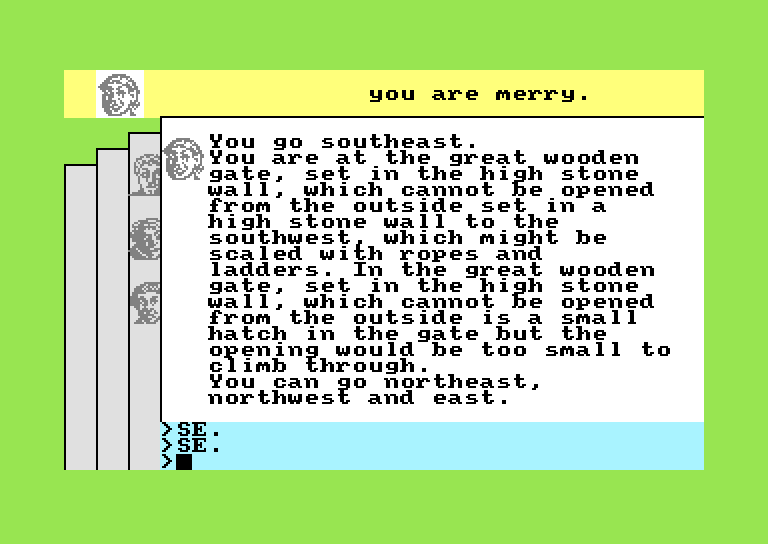 The authors of this game were believers in redundancy. Look at this text. Seriously, read it. The role-playing aspect is not entirely without glitches. One may for instance decide to take the role of Merry to first map out the environment, which has certain advantages over doing so in party mode with Frodo in the lead. However, when solitary Merry encounters certain set interactions, such as in Bree, he will be addressed in the plural form, as if the whole party were there. It can perhaps be understood why this mechanism has not survived in the interactive fiction genre; all those permutations would make a black rider weep. Next to the innovations there are some classic — and in the present day discarded — IF tropes; a maze lies waiting somewhere on an edge of the map, and the hobbits have a (in fact quite natural) dependency on food. If they get hungry, they will be able to carry less, become unreceptive of instructions, and ultimately break down. The hobbits burn food quicker when there is physical exertion involved, such as when operating the ferry across the Brandywine River. Having finally arrived at the stone bridge at the end of the first part I decline to play the second for the time being. Despite all the weirdness and slowness I do really want to like the game, but the prose is just a bit too brief, the responses of NPCs limited and robotic, and the resource management tedious. On the other hand, the game is quite original; it is certainly no literal retelling of the original story, and the player gets to visit parts of Eriador that are found in no other text adventure. Besides, any game that has such a grand ambition and such a popular source to draw from must be very interesting and instructive to play, if just for a little while and regardless of whether it succeeds as a game or not. Nobody sits down and starts singing about gold in this one! Graphics and platformsIn keeping with the landscape of the home computer market of the mid-1980s, the game was published for a variety of platforms. Melbourne House ported Lord of the Rings Game One to the Sinclair ZX Spectrum, Commodore 64, Amstrad CPC, and Acorn BBC Micro. Addison-Wesley, Melbourne House's counterpart in the U.S., published it under the name The Fellowship of the Ring for MS-DOS, Apple II, Apple Macintosh, and again for Commodore 64.  The loading screens for five different machines (can you spot them?); Sinclair ZX Spectrum, Commodore 64 (Melbourne House version), Amstrad CPC, Apple Macintosh, MS-DOS. Although the kernel of the game seems the same for both publishers, there are differences. The Melbourne House version was sold on disk or cassette — depending on computer brand — and features a small number of vector-based graphics to accompany the text, with the exception of the BBC Micro that operated in text-only Mode 7 (or "teletext" mode). A system of four small portraits that represent four hobbits show the player their relative locations amongst each other (sacrificing text area), reminiscent of RPGs. Also included is an easier "beginner's game" as an extra that is limited to Frodo's journey to Bree and features a built-in hint system, to get the player going if he has never played text adventures before. The Addison-Wesley game is exclusively disk-based and has many bit-mapped images to illustrate the game. The parser is a little bit more sophisticated, allowing the convenient "TAKE ALL" command. The Commodore 64 is the only machine for which both versions were available, and it is of course interesting to compare the two. In the Melbourne House edition we find a slightly modified character set and all of five very basic vector-drawn pictures of some (not all terribly exciting) locations. The beginner's game has a few more locations illustrated. The Addison-Wesley version has a more straight-forward layout, but features forty very nice and colorful bit-mapped images (the MS-DOS version has fifty). Comparing graphics of 1980s computers is terrific fun for those who lived through that age. Below are a number of screenshots of the opening scene in Bag End. Typical solid-color CRT "borders" have been removed in some cases.
Although the Addison-Wesley versions all have the same illustrations, the colors on the C64 augment them the best. The MS-DOS version uses only four colors (the very old-school CGA mode 1) but has a larger number of pictures. Sadly, the C64 version is also the slowest one to play (really, really slow). However, if the game is played on an emulated machine, this problem can be alleviated by simply increasing the speed of the emulator to 200% or more. Some notes for collectorsAs mentioned above, there were two publishers involved with marketing the game. In Europe and Australia the games were sold by Melbourne House, who had also originally developed the software, for Sinclair ZX Spectrum, Commodore 64, Acorm BBC Micro, Amstrad CPC, and Amstrad PCW, on cassette and disk, depending on the platform. In the U.S. Addison-Wesley sold versions for Commodore 64, Apple II, MS-DOS, and Apple Macintosh, all disk-only. Lord of the Rings Game One cassette version (Melbourne House)
Lord of the Rings Game One disk version (Melbourne House)
The Fellowship of the Ring (Addison-Wesley)
The Tolkien Trilogy (Beau Jolly)
Beau Jolly was a company that purchased the rights to dormant titles from their original publishers to re-release them as budget titles. The "Tolkien Trilogy", consisting of The Hobbit, Lord of the Rings Game One, and The Shadows of Mordor, was one of its efforts. According to the included (short and small-print) manual, cassette and disk editions of this collection were available for ZX Spectrum (cassette only), C64, and Amstrad CPC. A book offer was also included in the manual. Solution, pictures, and map (spoiler alert!)It's amazing how much time one can spend on documenting the user's side of a text adventure. But making a map is quite useful, and — for me at least — part of the fun.
Links
(Originally published 2019/05/18)
|
